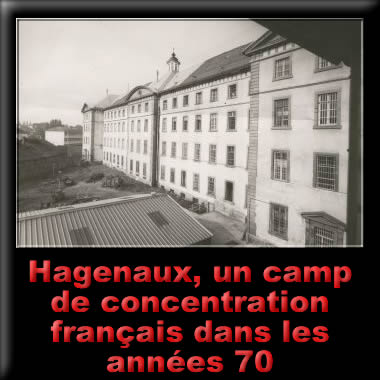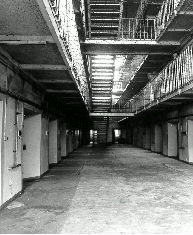 Prisoner
and laboratory rat at Haguenau
Prisoner
and laboratory rat at Haguenau
Jacqueline
de Croÿ - 14 avril 2007
It happened in France in the Sixties. He was
young and reckless. A Belgian guy had shown him the way to
burgle houses, what he saw as a game, which led him to a three
years of prison sentence whereas he was 22-years-old. By bad
luck, a warden came between him and another prisoner at the
time of a brawl, and his fist accidentally hit his facet.
Sentenced to an additional year for that, he made a hunger
strike, asking his transfer in another prison.
He had then been sent to Haguenau, a former military
and bourgeois and hospital, according to historians', which
would have known just one gloomy period during the war,
when the German army used it to lock members of the underground
army and political prisoner. After the war, Haguenau returned
to a woman' prison, then would have become a mixed prison
as from 1957 for the alleged innocents in waiting of their
judgement.
The prisoners would have benefited from daily
sports activities followed by compulsory showers, from studies,
from workshops and Sunday film shows. A disciplinary
district at the basement would have been a "cell without
television". An appendix of the prison would have been
reserved for the psychopaths, very few that the penitentiary
staff was to treat as normal people. There were watchtowers,
and guards had order to shoot at any prisoner who tried to
escape, but those who where confined to isolation did not
have right to the collective walks.
 In
1970, there were no women at Haguenau, not even among the
staff. The prisoner was greeted by a psychiatrist who asked
him five questions, then had him tied to a bed for two weeks,
in full isolation. He was injected nerve sedatives morning
and evening, maintained in a semi coma until he accepted the
replacement of the injection by a glass full of drinkable
sedative, which he had to take to the last drop in front of
the warden. He would then be able to hold on his legs and
join the collective walk.
In
1970, there were no women at Haguenau, not even among the
staff. The prisoner was greeted by a psychiatrist who asked
him five questions, then had him tied to a bed for two weeks,
in full isolation. He was injected nerve sedatives morning
and evening, maintained in a semi coma until he accepted the
replacement of the injection by a glass full of drinkable
sedative, which he had to take to the last drop in front of
the warden. He would then be able to hold on his legs and
join the collective walk.
All the prisoners were under the same massive
doses nerve sedative. Long period immobilization is a physical
and mental torture considered inhuman in the psychiatric hospitals,
for as long it exceeds between two to three days. It acted
of a "chemical brainwash", only possible treatment
that would enable to obtain that all the prisoners accept
the drugs.
The prisoner was then going to learn that the
doctors would chose some to evaluate the human physical and
mental limit, and in case of good conduct, it was enough to
say "no thank you", to be tied back to his bed for
two weeks. He said "no thank you" eight times, and
was tied to his bed during four and an half months on the
seven months he has spent there.
He has heard a man crying that he was dying,
without a doctor coming to untie him. He has heard another
man shouting that he was becoming mad, until his words had
no more sense and that an ambulance came to take him away,
proof that there was no quarter reserved to psychopaths. He
has seen men eating twisted spoons to be able to rest at hospital.
He has heard a guard saying to another:- "That is a good
doctor".
"I have not known the 'Club Med' period
of Haguenau.I was never been informed of 'Sunday film shows'
or 'sports activities'. It was forbidden to play football
in the yard and the prisoners could only take a shower on
Sunday. The weren't any more television in the cells than
in the disciplinary quarter".
Forced labour in France was not dissociable
from the prison sentence then, until the law of June 22, 1987,
reducing the prisoners to slavery in what was called "workshops".
A prisoner had thrown benzene at him and inflamed him. Back
from the hospital, his entire body burned, he was tied
to his bed. He was untied every morning and evening to go
back to hospital and change his bandages, proof that Haguenau
was not a hospital prison. He was then told that in order
to prevent he might want to take a revenge, the man who had
burned him would keep the normal treatment, and he would stay
in isolation until the end of his sentence. He was released
with more nerve sedatives than blood in the veins, without
previous treatment to cure the intoxication. His body quickly
withdrew in violent shakings.
The prison, a neo-classic monument built between
1783 and 1788, was closed in 1986, a year before the law abolishing
the slavery of prisoners, then partially destroyed due to
a "mushroom in its wooden frame". It was a dry prison,
assures the Haguenau survivor, who cannot imagine that
a mushroom could have settle there, invincible at the
point to justify the destruction of a prison (and 200-years-old
historical building), whereas France do not have enough cells
for its prisoners.
Historians just talk of the time the prison
detained only women, among which Violette Nozière,
famous in the thirties for having poisoned her incestuous
father, but also her mother, to save her from the shame, the
culpability and the remorse of having closed her eyes. The
silence that surrounds what has happened there under the guidance
of French doctors, the number of prisoners transformed by
force into unwilling laboratory rats, one imagines the true
reason for closing hides something else. The remains of building
were transformed into a game library, which was inaugurated
in 2001.